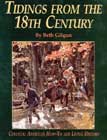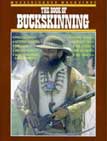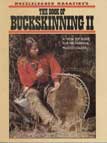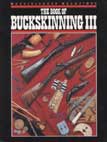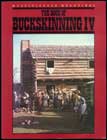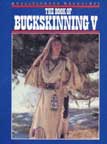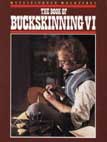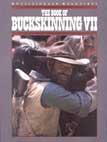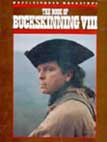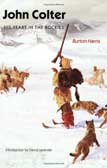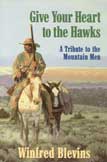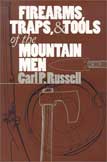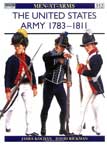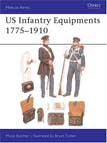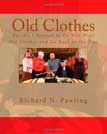

Beth Gilgun brings the mid to late 1700s to life with her entertaining and informative "letters" to a friend on the frontier. Great for reenactors, teachers, historic interpreters, and theatrical costumers. As an accomplished seamstress and goodwife, Gilgun shares with her "friend" information on clothing for men, women and children, as well as other topics of daily life in Colonial America. Included are clear, concise instructions for constructing reproduction 18th century garments, from choosing fabric to finishing. Her chatty letters include news about current events and the latest goods available on the East Coast.
*I met Beth Gilgun at a RevWar event once. I found her to be as neat in person as she seems in her books.
This book is a compilation of the first ten years of Mark Baker's column from Muzzleloader Magazine.
I don't know about you, but I have been a fan of Baker's for years... his ideas and articles are not only useful for his time-period, they also translate well to other time periods. Mark Baker truly IS one of the leading lights of "Experimental Archeology."
A Pilgrim's Journey contains over 300 pages of treks, scouts, hunts and how-to. Baker shares his knowledge and insights gained from wilderness experiences, extensive research, and from his partners and mentors along the way. Join Mark as he takes his pilgrim's journey back to the 18th century frontier. From flintlocks and moccasins to shooting bags and knapsacks, Baker explores the way of life of the Colonial woodsman. Learn about the clothing, accoutrements, food and skills from an era that helped forge the American Spirit and a new nation. Softcover. 306 pages with over 250 quality illustrations and photos, including many new photos in and updated layout.
Baker explores the longhunter's life in 18th century frontier America through the study of first-person accounts and hands-on research. In this second volume, Baker continues his pilgrim's journey to become an 18th century longhunter. Learn about the clothing, gear and food of the early American frontiersmen in his quest to discover the skills, lifestyle and mindset of those early woodsmen. Signed, limited edition hardcover with full-color dust jacket.
Step back in time and learn how to relive the American frontier. First published in 1981, this bestseller is the standard against which other frontier living history books are judged! Ten authors bring their expertise to the subjects of: The Philosophy of Buckskinning, How to Get Started, Rendezvous & Shoots, The Lodge, The Guns, The Clothing, Accoutrements & Equipment, The Skills, Women in Buckskinning, and The Crafts. Timeless information and inspiration for modern-day frontiersmen and women!
In-depth information on recreating life on the American frontier. Expand your enjoyment of living history with chapters including: Horseback Travel, Powder Horns, Canoeing, Camp Gear, Leather Clothing and Gun Tune-Up & Care. Each chapter was written by an experienced and knowledgeable participant in frontier reenacting. Lavishly illustrated with photographs and line drawings.
Explore recreating life on the American frontier. Solid information shared by knowledgeable and experienced reenactors help modern-day frontiersmen get started in the sport known as buckskinning. Subjects include: Historic Guns & Today's Makers, Quillworking, Trade Beads, 18th & 19th Century Cooking, The Hunting Pouch, Beadworking, Techniques for Making Footwear, and Period Shelters. Special color section of beadwork, quillwork, authentic frontier clothing, and trade bead photos
Enhance your frontier skills and knowledge. Each chapter was written by a knowledgeable and experienced participant in the sport known as buckskinning and lavishly illustrated with photos and drawings. Chapters include: Traditional Blacksmithing, Blankets in Early America, From Raw Hides to Rawhide, Styles of the Southwest, Smoothbores on the Frontier, Trade Silver, Backwoods Knives, Lighting the Primitive Camp, and Historic Sites & Museums. Emphasis is on demonstrating skills and how-to information.
Practical frontier American skills and knowledge are the focus in part five of this series on the sport known as buckskinning. Each chapter was written by a different author with in-depth knowledge of his or her topic. Chapters include: Fur Trade Indian Dresses; Old-Time Music & Instruments; Trade Goods for Rendezvous; Tipi Know-How; Engraving & Carving; Historic Sites & Museums II; Games, Sports & Other Amusements; and Pack Saddles & Panniers. Special color section features the dress of fur trade Indian women and horseback photos. Each chapter is abundantly illustrated with photos and drawings.
Hands-on frontier skills and in-depth historical information. Part six in this bestselling series on the pastime of recreating the American frontier, known as buckskinning, features more first-rate historical information and clear, hands-on instructions in the skills and crafts of the American pioneers. Chapters include: The Traditional Hunting Pouch, Horse Gear-East & West, Making a Wooden Bow, American Powder Horns, Frontier Trail Foods, Old-Time Shooting Matches, Period Trekking, and Finger Weaving. Special color section features photos of period horseback trips, powder horns, hunting pouches, and finger-woven sashes.
Best-selling guide to skills and crafts of frontier America. This book on the pastime of recreating the American frontier, known as buckskinning, continues the tradition of passing along accurate, practical information for the modern-day historian and reenactor. First-rate historical research and hands-on crafts include: Clothing of the Rocky Mountain Trapper, 1820-1840; Indian-Influenced Woodsmen of the Cane; Tools & Techniques of Bark Tanning; A Wardrobe for the Frontier Woman, 1780-1840; A Typical Day's Journey in Winter; Goods of the Trunk Maker & His Trade; Art & Writing on the Frontier; and Great Lakes & Eastern Woodlands Knife Sheaths. Includes a special color section featuring original art and artifacts plus reproductions. Each chapter was written by a knowledgeable participant in his field and is fully illustrated with photos and drawings.
Best-selling guide to skills and crafts of frontier America. Continuing the tradition with another in the bestselling series on the pastime of recreating the American frontier, known as buckskinning. Sound historical research and clear, understandable instructions in the crafts and skills of the American pioneers. Each chapter was written by an experienced participant and is lavishly illustrated. Chapters include: Gear of the Rocky Mountain Trapper, Beaver Hunting, Wing Shooting with a Flintlock Shotgun, History of the Horse in the Fur Trade, 18th Century Tatooing, The History & Trade Ledgers of Fort Hall, Independent Women of America's Past, Beadwork in the American West before 1850, and The Evolution of the Cocked Hat.
In 1822, before Jedediah Smith entered the West, it was largely an unknown land, “a wilderness,” he wrote, “of two thousand miles diameter.” During his nine years as a trapper for Ashley and Henry and later for the Rocky Mountain Fur Company, “the mild and Christian young man” blazed the trail westward through South Pass; he was the first to go from the Missouri overland to California, the first to cross the length of Utah and the width of Nevada, first to travel by land up through California and Oregon, first to cross the Sierra Nevada. Before his death on the Santa Fe Trail at the hands of the Comanches, Jed Smith and his partners had drawn the map of the west on a beaver skin.
Even among the mighty mountain men, Jim Bridger was a towering figure. He was one of the greatest explorers and pathfinders in American history. He couldn't write his name, but at eighteen he had braved the fury of the Missouri, ascending it in a keelboat flotilla commanded by that stalwart Mike Fink. By 1824, when he was only twenty, he had discovered the Great Salt Lake. Later he was to open the Overland Route, which was the path of the Overland Stage, the Pony Express, and the Union Pacific. One of the foremost trappers in the Rocky Mountain Fur Company, he was a legend in his own time as well as ours. He remains one of the most important scouts and guides in the history of the West.
The Christian Science Monitor has called this biography "probably the fairest portrait of Jim Bridger in existence." The New York Times has praise for a "painstaking job of research among the usual Bridger sources and among some others which have been neglected. . . . [The author] has adequately set the scene for his hero's adventures and has honestly appraised the great guide's historical stature.
Before his most fabulous adventure (celebrated by John G. Neihardt in The Song of Hugh Glass and by Frederick Manfred in Lord Grizzly), Hugh Glass was captured by the buccaneer Jean Lafitte and turned pirate himself until his first chance to escape. Soon he fell prisoner to the Pawnees and lived for four years as one of them before he managed to make his way to St. Louis. Next he joined a group of trappers to open up the fur-rich, Indian-held territory of the Upper Missouri River. Then unfolds the legend of a man who survived under impossible conditions: robbed and left to die by his comrades, he struggled alone, unarmed, and almost mortally wounded through two thousand miles of wilderness.
John Colter was a crack hunter with the Lewis and Clark expedition before striking out on his own as a mountain man and fur trader. A solitary journey in the winter of 1807-8 took him into present-day Wyoming. To unbelieving trappers he later reported sights that inspired the name of Colter's Hell. It was a sulfurous place of hidden fires, smoking pits, and shooting water. And it was real. John Colter is known to history as probably the first white man to discover the region that now includes Yellowstone National Park. In a classic book, first published in 1952, Burton Harris weighs the facts and legends about a man who was dogged by misfortune and "robbed of the just rewards he had earned."
This Bison Book edition includes a 1977 addendum by the author and a new introduction by David Lavender, who considers Colter's remarkable winter journey in the light of current scholarship.
Blevins portrays the incredible lives of such men as Jed Smith, Jim Bridger, Tom Fitzpatrick, and Bill Williams, while he looks for the greater story, the story of their experiences, rather than the political realities of their era.
In 1830, 16-year-old Osborne Russell left his Maine farm and ran away to sea. He didn't like it. He ended up joining an expedition headed to Oregon by way of the Rocky Mountains. Along the way he acquired the skills necessary for survival in the mountains. He also learned the Snake language, hunted buffalo, and trapped beaver, looked for new trails west, and kept a journal that forms the basis of this vigorously authentic book. The descriptions are so accurate that contemporary readers are using the book to retrace Russell's footsteps!
The true story (on which the film Jeremiah Johnson was partially based) of John Johnson, who in 1847 found his wife and her unborn child had been killed by Crow braves. Out of this tragedy came one of the most gripping feuds—one man against a whole tribe—in American history.
This encyclopedic guide to the equipment of the trappers and fur traders who opened the Old West is a unique reference work that can be classified either as history or as archaeology. It describes and discusses hundreds of iron artifacts—rifles, shotguns, hatchets, axes, knives, traps, and miscellaneous tools—used by the mountain men from the early 1800s to the mid 1840s.
Thirty years’ research went into the writing of this book. In addition to examining the diaries and letters of the trappers themselves, and the business records of fur-trading companies, the author also tracked down the records and catalogs of the gunsmiths, ironmongers, and other manufacturers who supplied the early traders. He observed most of the surviving artifacts, identified their makers, and traced the evolution of the styles and designs of the weapons and tools, usually from European origins.
Illustrated with over 400 drawings, the book begins with a useful background history of the western fur trade. Among the sections that will appeal to special groups of readers are chapters on firearms and blacksmithing and an appendix on the “Historic Objects as Sources of History.”
When the Revolutionary War (1775-1783) ended Washington's victorious Continental Army was disbanded. The infant United States had very mixed feelings about standing armies; but years of Indian-fighting on the frontier emphasised the need for a force larger than Josiah Harmar's original 700-man 1st American Regiment. In the event Secretary Hamilton's far-sighted reforms, which produced 'Wayne's Legion' in the early 1790s, were to be short-lived, and it took later threats of international war to stimulate the eventual expansion of the young US Army. James Kochan's meticulously researched study of a dramatic and confused period in American military history - the years of St Clair's disaster, 'Mad Anthony' Wayne's victory at Fallen Timbers, and Harrison's at Tippecanoe - is illustrated with many rare and important paintings and drawings.
The development of US Army infantry equipment has been a story of trial and error, of adopting new designs to meet new problems. It was not until 1910 that a whole system of equipment, including everything from the waist belts to the canteens to the cartridge-carriers to the haversack, was officially adopted. Prior to that, each piece of equipment was designed to meet a specific need, without any consideration of anything else the soldier had to carry. Packed with photographs and illustrations, this book explores the history of US Infantry equipments from 1775 to 1910, covering everything from blankets to bayonets.
This book is an indispensable guide to the often misunderstood field of living history. It presents the actuality that there is a great deal more involved in this discipline than merely “wearing old clothes and going back to the past.” This volume succinctly captures the perspectives that Richard Pawling has gained from over thirty-five years of experience in the interpretive profession (in county, state and national parks and as entrepreneur and owner of Rich Pawling’s History Alive!). Here, Pawling shares his observations and advice about everything from designing a living history persona to his successful use of this provocative teaching technique in the college classroom, to the role of research in helping you to learn about your own genealogical past. Though written for a broad audience, this book should be of particular interest to those employed as an interpretive park ranger or a naturalist, a museum or tour guide, or those who volunteer as a military reenactor or as a docent at a park, museum or historic site. Old Clothes presents the important lessons Pawling has learned along the way, the most important of which is that “life is a journey and understanding our past plays an important role in helping us to continue to learn not only about life in general, but more importantly, about ourselves.”
Pope Julius II excommunicates Italian state of Venice
Treaty of St. Truiden: anti-French Trapdoors / Bourgondisch covenant
Battle at Bicacca: Charles I and Pope Adrianus VI beat France
Mogol King Babur beats Sultan of Delhi
1st Spanish settlement in Philippines, Cebu City, forms
Peace of Beaulieu and Paix de Monsieur
King Charles I flees Oxford
Scottish general Montrose defeated
Netherlands and France sign military covenant
Frederik August I "the Strong" becomes Monarch of Saksen
Battle at Culloden Moor: Duke of Cumberland beats "James VIII & III"
US Marines attack shores of Tripoli
Americans under General Pike capture Toronto; Pike is killed
Fire destroys half of Charleston
Imakita Kosen, 1st Zen teacher of D.T. Suzuki, found the awakening
Establishment of Jewish congregations in Lower Austria prohibited
"Pomona" sinks in North Atlantic drowning all 400 aboard
Thomas J Jackson is assigned to command Harpers Ferry
President Abe Lincoln suspends writ of habeas corpus
West Virginia secedes from Virginia after Virginia secedes from US
Cornell University (Ithaca NY) is chartered
Heinrich Schliemann discovers Troi
White League, Paramilitary white supremacist organization, forms
Opera "Le Roi de Lahore" is produced (Paris)
President Hayes removes Federal troops from LA, Reconstruction ends
Pogroms against Russian Jews start in Elisabethgrad
1st Highlander (Yankee) shut-out, Philadelphia Athletics win 6-0
World Exposition opens in Luik
Sultan of Turkey Abdul Hamid II is overthrown
Belgian parliament rejects socialist motion for general voting rights
Relief laws replaces those of 1854, in the Netherlands
Pogrom leader Petljoera declares Ukraine Independence
Hadjememaar, [Corn de Gelder] elected in Amsterdam
Fritz Langs "Dr Mabuse, der Spieler" premieres in Berlin
Yakut ASSR formed in Russian SFSR
Mussolini government italian place in South Tirol / Alto Adige
Antwerp soccer tie Belgium-Netherlands 1-1
Karl Jansky reports reception of cosmic radio signal in Washington DC
Yanks pull a 1st inning triple-play and beat Philadelphia Athletics 9-8
1st US social security payment made
US Social Security system makes its 1st benefit payment
Himmler orders establishment of Auschwitz Concentration Camp
German troops occupy Athens Greece
Belgium Jews are forced to wear stars
Tornado destroys Pryor Oklahoma killing 100, injuring 300
Lou Jansen and Jan Dieters arrested, lead illegal CPN party in Holland
Soviet Union breaks contact with Polish government exiled in London
Boston Brave Jim Tobin no-hits Brooklyn Dodgers, 2-0
2nd Republic of Austria forms
Italian partisans capture Mussolini prisoner
US 5th army enters Genua
1st radar installation aboard a coml ship installed
Babe Ruth Day celebrated at Yankee Stadium and through out US
Arab legion attacks Gesher bridge on Jordan River
"Tickets, Please" opens at Coronet Theater NYC for 245 performances
South Africa passes Group Areas Act segregating races
Mohammed Mossadeq chosen Premier of Persia
"4 Saints in 3 Acts" closes at Broadway Theater NYC after 15 performances
1st general elections in British Guyana, won by Jagans PPP
Wrestler Freddie Blassie coins term "Pencil neck geek"
Heavyweight champ, Rocky Marciano, retires undefeated from boxing
"Today" show goes abroard 1st time (Paris France)
Liu Sjau-chi elected President of China PR
1st atomic powered electric-drive submarine launched (Tullibee)
South Korean President Syngman Rhee resigns
Togo (formerly French Togo) declares independence from French adm
NASA launches Explorer 11 into Earth orbit to study gamma rays
NFL officially recognizes Hall of Fame in Canton, Ohio
Sierra Leone declares independence from the UK
"Jopie" Pengel forms government in Suriname
Cuban Premier Fidel Castro arrives in Moscow
RC Duncan patents "Pampers" disposable diaper
Dmitri Shostakovitch completes his 2nd cello concert
Rocky Marciano retires as undefeated boxing champ
"Education of Hyman Kaplan" closes at Alvin NYC after 28 performances
Baltimore Oriole Tom Phoebus no-hits Boston, 6-0
Congress of Political Party Radicals (PPR) forms in the Netherlands
Carol Mann wins LPGA Raleigh Ladies Golf Invitational
Curt Flood resigns Senators after 13 games and departs for Denmark
Apollo 16 returns to Earth
New York City Mayor John Lindsey appeals that John Lennon not be deported
Kansas City Royal Steve Busby no-hits Detroit Tigers, 3-0
Pan Am 707 crashes into mountains of Bali, killing 107
Sandra Haynie wins LPGA Charity Golf Classic
"So Long 174th St" opens at Harkness Theater NYC for 16 performances
Arabic Monetary Fund established in Abu Dhabi
Bloody riots in Soweto South Africa
HCC, Hobby Computer Club, forms in the Netherlands
Accident at nuclear reactor Willow Island, W Virginia, kills 51
George Harrison releases "Love Comes to Everyone"
Barbara Barrow wins LPGA Birmingham Golf Classic
1st female soccer official is hired by NASL
Beatle Ringo Starr marries actress Barbara Bach [Goldbach]
Nordiques 1-Isles 4 - Semifinals - Isles hold 1-0 lead
Trial of John W Hinckley Jr attempted assassin of Reagan, begins
Nolan Ryan becomes strikeout King (3,509), passing Walter Johnson
Cleveland Indians beat Detroit Tigers, 8-4, in 19 innings
Over 70 inches of snow falls on Red Lake, Montana
"Sweet Charity" opens at Minskoff Theater NYC for 368 performances
Captain Midnight (John R MacDougall) interrupts HBO
Pat Bradley wins LPGA S&H Golf Classic
US Justice Department bars Austrian Chancellor Kurt Waldheim from entering US, due to his aid of Nazi Germany during WWII
"Starmites" opens at Criter Ctr SR Theater NYC for 60 performances
Beijing students take over Tiananmen Square in China
Hurricane in Bangladesh, kills 500
Mandatory seatbelt law goes into effect in Italy
50th annual barbershop quartet singing convention held (Mich)
Dodger Orel Hershiser undergoes career-threatening shoulder surgery
Firestone World Bowling Tournament of Champions won by David Ozio
"Small Family Business" opens at Music Box Theater NYC for 48 performances
New York Jets finish perfect 5-0 pre-season for 1st time
New York Mets trade David Cone to Toronto Blue Jays for Jeff Kent
Afghan Antonov AN-32 crashes at Tashqurgan, kills 76
"Inspector Calls" opens at Royale Theater NYC for 454 performances
7th longest NHL game: New Jersey Devils beat Buffalo Sabres (125 min 43 seconds)
Graeme Obree bicycles world record time (52,713 km)
President Nixon buried in Nixon Library in California
Twins righty Scott Erickson no-hits Brewers 6-0
"Indiscretions" opens at Ethel Barrymore Theater NYC for 221 performances
Coors Field in Colo opens - Denver Rockies beats Mets 11-9 in 14
"Little Foxes, " opens at Vivian Beaumont NYC for 56 performances
"Stanley, " closes at Circle in the Square Theater, New York City
Frank Nobilo wins Greater Greensboro Chrysler Classic at Forest Oaks
Las Vegas Senior Golf Classic by TruGreen-ChemLawn
Nancy Lopez wins LPGA Chick-fil-A Charity Championship
